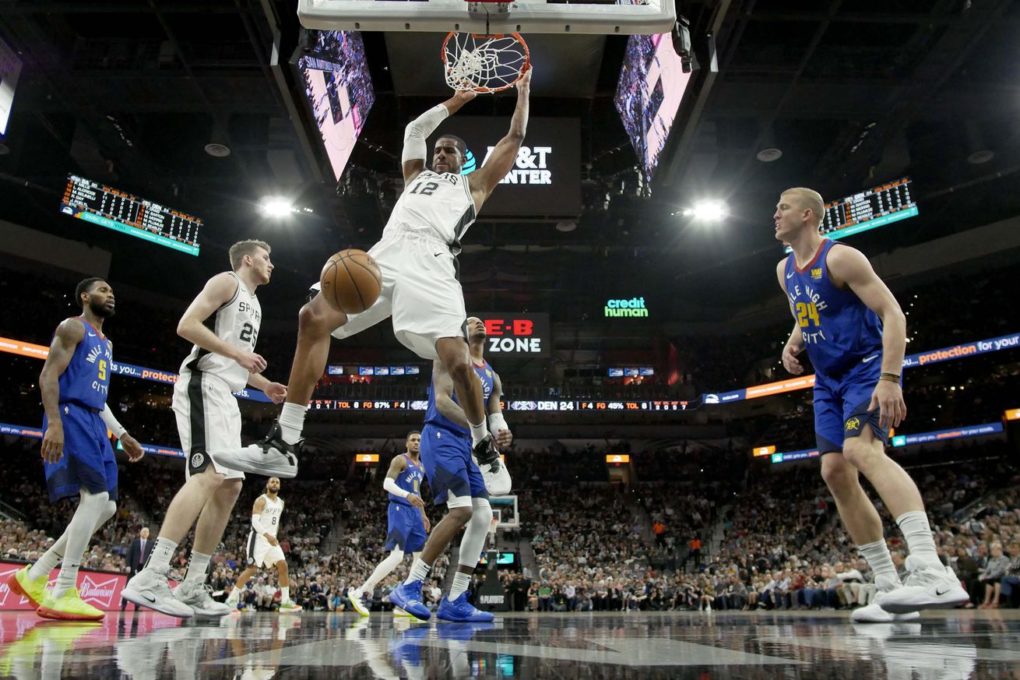How the Spurs’ inside-out attack keyed their best offensive game of the series

The Spurs found their happy place on offense in Game 6. Can they do it again in Game 7?
The Spurs pulled another magic trick in their Thursday night Game 6 victory over the Nuggets. After struggling to generate high quality looks from deep for their best shooters, the Spurs somehow scored more points off three-pointers than they had in any game of the series on the night they benched one of the league’s best shooters.
Davis Bertans is so good from beyond the arc that Spurs’ fans almost revolted when he wasn’t included in the three-point contest this year. And yet, the Spurs had their best offensive game of the series without him.
That’s not an indictment of Davis, who’s just trapped in a bad match-up and would likely shine in most other series; it’s a sign of how the Spurs’ offense differs from most of the rest of the league.
Rather than play more shooters to get more space, the Spurs doubled down on their offensive approach. The basic premise is simple: put pressure on the rim and find the best shot you can on the way there.
The Spurs were much more assertive in their attempts to get to the basket right from the tip than they’ve been at almost any point this season. On their very first possession, Derrick White tried an unusually aggressive pocket pass to LaMarcus Aldridge as he rolled out of the Nuggets’ attempt to hedge on a pick and roll.
/cdn.vox-cdn.com/uploads/chorus_asset/file/16194987/DWppAttemptDefl.gif)
Paul Millsap got the blind deflection with his active hands, but the Spurs retained possession after it rolled out of bounds off Denver. DeMar DeRozan would hit a baseline floater from 10 feet on the ensuing inbounds play, but the Spurs continued to work into the lane at every opportunity.
The Spurs got a paint touch on each of the next 6 possessions, scoring 10 points without taking a single three-pointer, all fueled by post-ups and dribble penetration. It wasn’t just a matter of one player creating while everyone else stood around, though. The Spurs used a variety of actions, angles and movement to produce open looks.
Jakob Poeltl, in particular, did an excellent job of finding just the right spot to create passing lanes, and was the beneficiary of two beautiful assists on consecutive plays.
Both DeMar’s drop off and Aldridge’s high-low were great passes, but neither can happen without Jakob exploiting the defense’s momentary focus on the Spurs’ stars. He wasn’t just hunting easy points for himself though, Jakob’s off ball movement created space all over the floor.
After dropping just below the backboard for another potential dump off for a layup on LaMarcus’ drive, Jakob slips to the dunker spot on the left side. With the Nuggets’ attention all on DeMar at the top of the key, Jakob sees that Nikola Jokic is setting up to help if DeMar drives.
Paul Millsap is glued to the block, too, apparently unconcerned about LaMarcus drifting out along the baseline. So Jakob motions for DeMar to drive and kick, then seals Millsap, giving LaMarcus a wide open three, which he drills. After so much early success getting into the paint, the Spurs had already forced the Nuggets to make concessions on the perimeter.
They maintained that pressure on the Nuggets’ interior defense for the entire quarter, taking 10 shots from 4 feet or closer in the first 12 minutes of game 6 and attempting just 3 threes. The drives, post ups, and most importantly, interior movement and passing all combined to force the Nuggets’ defense to compress. And as the Nuggets defense slowly tightened up on the interior, the Spurs’ shot attempts migrated outward.
The heat maps of their field goals attempts by quarter tells the story.
Despite playing just three real shooters — Bryn Forbes, Patty Mills, and Marco Belinelli — the Spurs managed to generate 20 open and wide open three point attempts, their most of the series. By the end of the game, the Spurs actually ended up with their lowest percentage of shots at the rim in the series, but with their highest percentage from three, per Cleaning the Glass.
Of course, all that early pressure on the rim doesn’t have the same effect if the Spurs aren’t knocking down those shots, nor would it have mattered if they couldn’t hit from outside once they had the opportunity. There’s simply no substitute for made baskets. But if the Spurs can continue this inside-out attack in Game 7, they’ll at least give themselves a chance to hit the shots they need.
How the Spurs’ inside-out attack keyed their best offensive game of the series
Source: Pounding The Rock
















